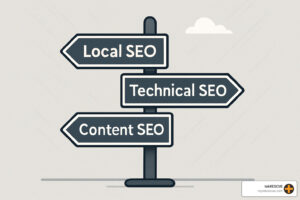

Click-Through Rate & Bounce Rate for SEO Your San Marcos Texas Search Engine Optimization Experts Discuss
Search Engine Optimization is an ever-changing field, and we do our best to stay up with the latest trends and changes to help ensure that we’re helping–not hurting–clients’ websites. We focus primarily on optimizing for Google because that’s where the lion’s share of traffic comes from. While Google’s exact algorithm is kept under lock-and-key, we know the basics that help a website rank better for desired keywords. We look at things such as on-page optimization, interlinking and crawlability, content freshness & relevance, the list goes on.
Two important, and often-overlooked, factors for ranking are click-through-rates and bounce-rates. we’re going to explain each factor in-depth and explain why they’re important factors in Google’s eyes. Before we begin, put yourself in the shoes of those who run Google… Their end-goal is to provide users with exactly the content they’re looking for quickly. This leads to a good user experience, which brings people back to the search engine over and over. When people visit and use Google, Google can sell and monetize ad space in their search results, which brings in more money. It’s a win-win-win: The users win because they find the info they need, Google wins because they sell ad space, and advertisers win because they are able to precisely target people with a need they can fill. Let’s take a look at two quality factors that Google uses to determine how well the content they serve up is what people are searching for.
Click-Through Rate
Click-through rate can be described in straightforward terms: it’s the number of times a listing is viewed versus how many time it’s clicked. So this means that if you’re on the first page of a Google search engine results page (Google SERP) for a keyword that receives 1000 searches per month, and your listing is clicked 100 times during the month, you have a CTR of 10% (please note: to keep things straight-forward we’re assuming that everyone scrolls down the page to see all 10 results, so this example doesn’t factor in results that are “below the fold”). If Google starts to notice that a certain listing is getting clicked on more than the others (a higher CTR) it will often reward that listing with a higher position.
There are two important nuggets to take away from this.
The first: The Top 3 results for any keyword generally have an advantage over lower results. It’s no secret that the top three results often get the most clicks… think about your own searching habits–how often do you find yourself clicking on the first, second, or third result, instead of scrolling down to look at others?
The second: It is important to take the time to properly optimize your page titles and meta descriptions. The page title is the big blue link at the start of each result listing in Google, and is the most eye-catching part of the results (aside from pictures and star-ratings). The meta description is the snippet of text below the blue title and green URL. Many people don’t set these, so Google has to make do with pulling content from the page itself. This can lead to random snippets of sentences, truncated titles, random words in the listings and more–all of which can hurt your click-through rate.
Our Recommendation: If you use a WordPress site, be sure to install an SEO plugin such as Yoast on your site. When you’re editing your pages and posts you’ll be able to set the page title and meta-description as it will appear in Google’s SERPs. Make your headlines and meta-description content attractive and intriguing to entice visitors to click. However, don’t mislead people, because it can hurt the bounce rate, which we’ll look at next.
Bounce Rate
If someone visits your website by clicking on your listing in Google, skims your page, decides it’s not what they’re looking for, clicks the back button, and continues browsing through Google’s results for a different site, Google takes notice. The act of visiting a page, then leaving without browsing other pages is what’s known as a bounce. High bounce rates on a page are a good indicator to Google that the listing doesn’t help people searching for particular information, so they’ll push the result down in the listings in favor of other pages with lower bounce rates.
However, what about pages that provide the exact information a user is searching for? What if they visit the page, are satisfied with the information presented, then carry on their day without clicking around more on your site? Fortunately, Google is pretty good at not punishing pages for this type of reason. The algorithm looks at bounce metrics and visit duration methods across similar pages for similar keywords, so it is able to smartly identify about how long the typical visit/bounce-rate is and adjust accordingly.
Our Suggestion: As one of the leading SEO companies in San Marcos & Central Texas, we recommend ensuring that the content on your landing page is entertaining or informative, and that it is engaging enough to keep people on the page for a few minutes or browse around further. If you have a high bounce rate (install an analytics script such as Google Analytics or Clicky to view this kind of data), consider rewriting, adding more content or pictures… and video is a great way to boost retention and engagement!
We’re the SEO company for Austin Texas and San Marcos businesses of all types and sizes. If you’re looking at different Austin TX SEO companies, look no further! Contact us today to discuss your needs – we’ll analyze your current site and make suggestions, and we’ll be happy to roll out tweaks and content that can help boost your website’s rankings in the search engines.




